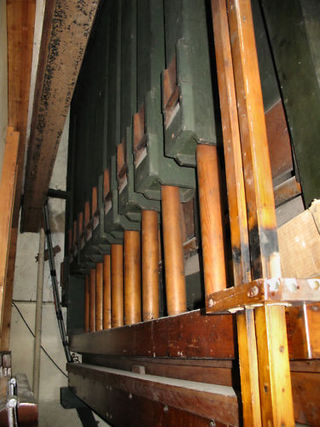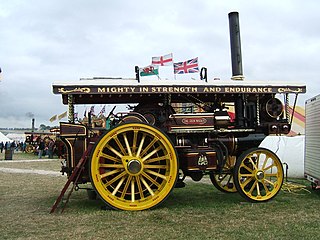
The pipe organ is a musical instrument that produces sound by driving pressurised air through the organ pipes selected from a keyboard. Because each pipe produces a single pitch, the pipes are provided in sets called ranks, each of which has a common timbre and volume throughout the keyboard compass. Most organs have many ranks of pipes of differing timbre, pitch, and volume that the player can employ singly or in combination through the use of controls called stops.

In music, the organ is a keyboard instrument of one or more pipe divisions or other means for producing tones. The organs have usually two or three, up to five manuals, for playing with the hands, and pedalboard, with the feet. With the use of registers, several groups of pipes can be connected to one manual.

A combination tone is a psychoacoustic phenomenon of an additional tone or tones that are artificially perceived when two real tones are sounded at the same time. Their discovery is credited to the violinist Giuseppe Tartini and so they are also called Tartini tones.

An organ stop is a component of a pipe organ that admits pressurized air to a set of organ pipes. Its name comes from the fact that stops can be used selectively by the organist; each can be "on", or "off".

Scaling is the ratio of an organ pipe's diameter to its length. The scaling of a pipe is a major influence on its timbre. Reed pipes are scaled according to different formulas than for flue pipes. In general, the larger the diameter of a given pipe at a given pitch, the fuller and more fundamental the sound becomes.

A theatre organ is a type of pipe organ developed to accompany silent films, from the 1900s to the 1920s.

A flue pipe is an organ pipe that produces sound through the vibration of air molecules, in the same manner as a recorder or a whistle. Air under pressure is driven through a flue and against a sharp lip called a labium, causing the column of air in the pipe to resonate at a frequency determined by the pipe length. Thus, there are no moving parts in a flue pipe. This is in contrast to reed pipes, whose sound is driven by beating reeds, as in a clarinet. Flue pipes are common components of pipe organs.

An organ pipe is a sound-producing element of the pipe organ that resonates at a specific pitch when pressurized air is driven through it. Each pipe is tuned to a note of the musical scale. A set of organ pipes of similar timbre comprising the complete scale is known as a rank; one or more ranks constitutes a stop.
Bourdon, bordun, or bordone normally denotes a stopped flute/flue type of pipe in an organ characterized by a dark tone, strong in fundamental, with a quint transient but relatively little overtone development. Its half-length construction makes it especially well suited to low pitches, and economical as well. The name is derived from the French word for 'bumblebee' or 'buzz'.

Robert Hope-Jones was an English musician who is considered to be the inventor of the theatre organ in the early 20th century. He thought that a pipe organ should be able to imitate the instruments of an orchestra, and that the console should be detachable from the organ.
Ophicleide and Contra Ophicleide are powerful pipe organ reed pipes used as organ stops. The name comes from the early brass instrument, the ophicleide, forerunner of the euphonium.

The Boardwalk Hall Auditorium Organ is the pipe organ in the Main Auditorium of the Boardwalk Hall in Atlantic City, New Jersey, built by the Midmer-Losh Organ Company. It is the largest organ in the world, as measured by the number of pipes.
Gedackt is the name of a family of stops in pipe organ building. They are one of the most common types of organ flue pipe. The name stems from the Middle High German word gedact, meaning "capped" or "covered".

St Mary Moorfields is a Roman Catholic church in Eldon Street near Moorgate, on a site previously known as Moorfields. It is the only Catholic church in the City of London. Prior to a 1994 boundary change, the church was in the Borough of Hackney, such that there were no Catholic churches in the City.
A tibia is a sort of organ pipe that is most characteristic of a theatre organ.
An organ pipe, or a harpsichord string, designated as eight-foot pitch (8′) is sounded at standard, ordinary pitch. For example, the A above middle C in eight-foot pitch would be sounded at 440 Hz.
Registration is the technique of choosing and combining the stops of a pipe organ in order to produce a particular sound. Registration can also refer to a particular combination of stops, which may be recalled through combination action. The registration chosen for a particular piece will be determined by a number of factors, including the composer's indications, the time and place in which the piece was composed, the organ the piece is played upon, and the acoustic environment within which the organ resides.

The Scarborough Fair Collection is a museum of fairground mechanical organs and showman's engines, located in Scarborough, North Yorkshire, one of the largest collections of its type in Europe.

The Odeon Cinema, Weston-super-Mare in Somerset, England, is an art deco cinema building, designed by Thomas Cecil Howitt. Still largely intact and retaining its originally installed Compton organ, it is a Grade II listed building.

Casavant Frères Ltée. Opus 1841 is a pipe organ built by the famous Casavant Frères of Saint-Hyacinthe, Quebec. The organ was first completed in 1911 as Casavant Brothers - Opus 452 for St. Andrew's Presbyterian Church at 40 Bentinck Street, Sydney, Nova Scotia, Canada. St. Andrew's later became St. Andrew's United Church and is now the Highland Arts Theatre.












